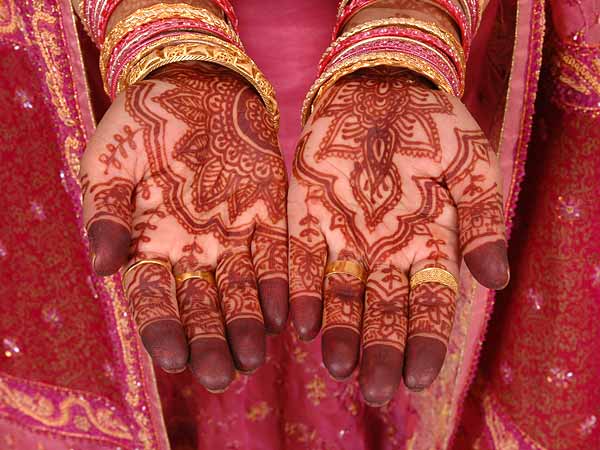Significance of Bridal Mehendi
In context of an Indian bride, mehndi is believed to signify the strength of her marriage as well as the amount of love that she will receive in her husband's house. In fact, it is said that the darker the color of the mehendi (on the hands and the feet of a bride), the stronger will be the marriage and longer it will last. At the same time, the dark color of henna is also said to mean that the bride will receive a lot of love from her husband as well as her in-laws. This is the reason why, after the application of bridal henna designs, the bride undertakes a lot of efforts, like applying oil or heat, to ensure that the color is dark. The application of henna, on the bride's hands and feet, is also considered to be auspicious.
Bridal Mehendi Designs & Patterns
Amongst the traditional henna designs, drawn on the hands and feet of a bride, one can include the 'baraat' scene and the 'doli' scene. Baraat is the term used to denote the procession of the groom, including all his family members, relatives and friends, before he arrives at the wedding venue. 'Doli' signifies the end of a wedding ceremony, when the bride goes away with her husband. Both of these designs are extremely intricate and involve long hours of labor. Apart from that, the common bridal mehendi designs include peacock, kalash, flowers, leaves and conch-shells. Whatever be the design, drawing images of the bride and groom, as well writing the groom's name, on bride's hands, is compulsory.
Modern Trends
With the changing times, the type as well as style of bridal mehndi has also undergone a vast change. Rather than the traditional mehndi (made from henna leaves), brides have started opting for tattoo mehendi, chemical mehendi, stone mehendi and even sparkle mehendi. In these types of mehndi, altogether different designs are used and accessories like tattoos, sparkles and stones are added to make eye-catching patterns. Some other henna concepts that one can find in the present times include zardozi mehndi, nail paint mehndi and poster color mehndi. One of the main reason brides are opting for the new styles is that their application takes much lesser time and they do not require hours of drying.
Mehndi Ceremony
Initially, mehendi used to comprise of a small ceremony, in which only the close female relatives and the friends of the bride were invited, along with the family members. They used to apply mehendi on the hands of the bride as well as each other. In the present times, the ceremony has undergone a lot of change. Now, men have also become a part of the ceremony, where the guest list includes almost all the people who are invited to the wedding. Professionals are called in, to apply henna to the bride as well as the guests. Drinks, an elaborate dinner and a rocking DJ form the other aspects of the present-day mehendi ceremony.
 Popular Henna Patterns and Designs
Popular Henna Patterns and Designs


